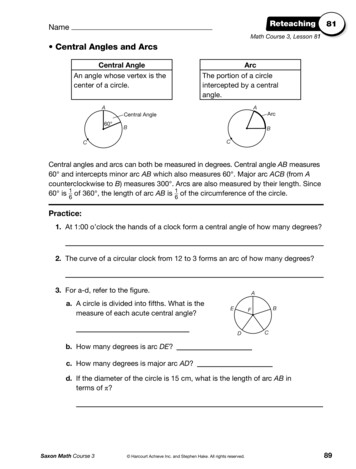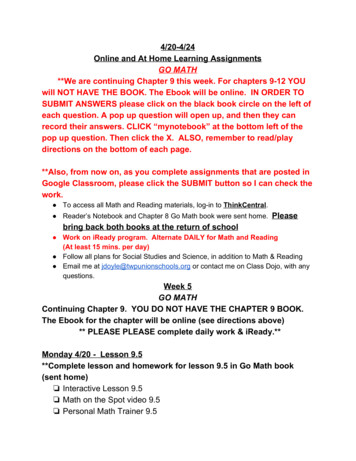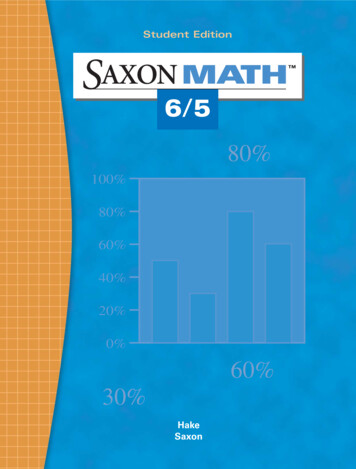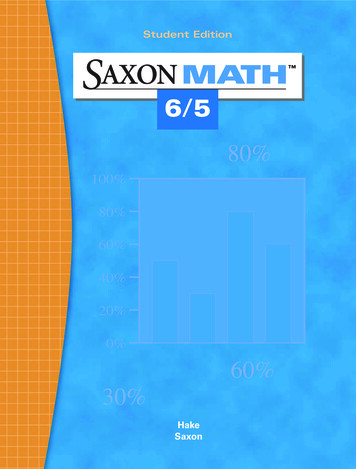
Transcription
ReteachingName81Math Course 3, Lesson 81 Central Angles and ArcsCentral AngleAn angle whose vertex is thecenter of a circle.AArcThe portion of a circleintercepted by a centralangle.A B)H?BCCCentral angles and arcs can both be measured in degrees. Central angle AB measures60 and intercepts minor arc AB which also measures 60 . Major arc ACB (from Acounterclockwise to B) measures 300 . Arcs are also measured by their length. Since60 is 16 of 360 , the length of arc AB is 16 of the circumference of the circle.Practice:1. At 1:00 o’clock the hands of a clock form a central angle of how many degrees?2. The curve of a circular clock from 12 to 3 forms an arc of how many degrees?3. For a-d, refer to the figure.a. A circle is divided into fifths. What is themeasure of each acute central angle?AEBFDCb. How many degrees is arc DE?c. How many degrees is major arc AD?d. If the diameter of the circle is 15 cm, what is the length of arc AB interms of π?Saxon Math Course 3 Harcourt Achieve Inc. and Stephen Hake. All rights reserved.89
ReteachingName82Math Course 3, Lesson 82 Graphing Equations Using InterceptsStandard Form of a Linear EquationAx By CHere’s an easy way to graph linear equations in standard form: 3x 5y 15Step 1: Choose zero for each variable.1.xyStep 2: Solve for the other variable.0Step 3: Graph the solutions.0If we choose 0 for x, then 5y 15.3(0) 5y 152.If we choose 0 for y, then 3x 15.xy03503x 5(0) 15By choosing 0 for x and 0 for y we have found thex- and y-intercepts of the equation’s graph.3.y(0,3)(5,0)xPractice:Find the x- and y-intercepts of the following equations, then graph them.1. 3x – y 92. x 4y –83. 2x – 7y 144. 4x 2y 165. 3x 6y 990 Harcourt Achieve Inc. and Stephen Hake. All rights reserved.Saxon Math Course 3
ReteachingName83Math Course 3, Lesson 83 Probability of Dependent EventsTo determine the probability of events that are independent, multiply the probabilityof each event.P(A and B) P(A) P(B)The probability of some events, however, depend on the outcome of other events.For non-independent events, the multiplication rule looks like this:P(A under initial conditions) P(B under new conditions)Example:Two 5-dollar bills and one 1-dollar bill are in an envelope. If twobills are picked out at random, what is the probability that the two5-dollar bills will be picked?Step 1: Determine the probability of the first event.Since 2 of the 3 bills are 5-bills, the probability that thefirst bill picked is a 5-bill is 23.Step 2: Determine the probability of the second event.If a 5-bill has been picked, then 1 of the 2 remaining billsis a 5-bill. The probability that the second bill picked willbe a 5-bill is 12.Step 3: Apply the multiplication rule.2 1 1 The probability that both 5-bills will be3 23 picked is 1.3Practice:1. Six cards colored red, blue, green, yellow, white, and orange are face down onthe table. Find these probabilities.a. turning over the yellow card firstb. turning over yellow and then green2. Miesha has 3 red pens and 2 black pens in her pencil case. If she selects twopens without looking what is the probability that:a. the first will be black?b. the first will be black and the second will be black?c. the first will be red and the second will be black?Saxon Math Course 3 Harcourt Achieve Inc. and Stephen Hake. All rights reserved.91
ReteachingName84Math Course 3, Lesson 84 Selecting Appropriate Rational NumbersWhen solving problems with percents, you can choose between using the decimalform or the fraction form. Which do you choose? The better choice depends onthe situation.1 of 10.00?Example One: What is 25% of21Think: Both 25% and easily convert to decimal form.2StepJustification1 of 10.0025% ofGiven21 to decimals0.25 0.5 10.00Converted 25% and20.125 10.00Multiplied 0.125 0.5 1.25MultipliedExample Two:3 of 10.00?1% ofWhat is 3353Think: Since 13 converts to a repeating decimal, we choose to convert33 13% to a fraction before performing the calculations.Step3 of 10.00?1 % of3353JustificationGiven3 10.001 Convert to fraction1 10.00531 Multiplied53 2.00Multiplied35Practice:1. To find 60% of 32.50, would you convert 60% to a fraction or a decimal? Why?2. Find 60% of 12 of 16.00.3. Find 50% of 12 of 32.00.4. Find 66 23% of 12 of 18.00.5. To find 66 23 % of 18.00 would you convert 66 23 % to a fraction or a decimal?Why?92 Harcourt Achieve Inc. and Stephen Hake. All rights reserved.Saxon Math Course 3
ReteachingName85Math Course 3, Lesson 85 Surface Area of Cylinders and PrismsThe surface area of a solid is the total area of all of the surfaces of the solid. For acylinder the surface area includes two circles and the curved side.area of this circlearea of lateral surfaceAdd to find the total surface area.area of this circleThe lateral surface area of a cylinder or prism is the area of the surfaces between thebases and does not include the bases.lateralsurfacesFormula for Lateral Surface AreaLateral Surface Area Perimeter of base heightPractice:1. How many different surfaces do each of these solids have?:a.b.c.cylindertriangular prismrectangular prism2. Describe a shortcut for finding the lateral surface area of a prism.Find the lateral surface area, a, and the total surface area, b, of these figures:3.4.10 in.Saxon Math Course 3a.a.b.b. Harcourt Achieve Inc. and Stephen Hake. All rights reserved.93
ReteachingName86Math Course 3, Lesson 86 Volume of Pyramids and ConesTo find the volume of a cone or pyramid we first find the volume of a cylinder orprism with the same base and height. Then we divide that volume by 3, because thevolume of a cone or pyramid is 13 the volume of the cylinder or prism.Formula for the Volume of a Cone or Pyramid1B hV 3Practice:1. Find the volume of a cone that is 12 cm high and has a base 6 cm in diameter.(Express in terms of π.)2. The height of the square pyramid is 5 inches.What is its volume?6 in.6 in.3. What is the volume of a rectangular pyramid with a height of 10 cm and with abase 12 cm long and 8 cm wide?4. What is the volume of a cone with diameter 6 m and height 5 m? Use 3.14 for πand round to the nearest whole cubic meter.94 Harcourt Achieve Inc. and Stephen Hake. All rights reserved.Saxon Math Course 3
ReteachingName87Math Course 3, Lesson 87 Scale Drawing Word ProblemsThe scale of a drawing or model is a ratio relating lengths on the drawing or model tolengths on the actual object.To solve scale drawing problems we use the scale ratio to write a proportion.Be careful to use the correct units of measure.Example:The scale of the building plans is 1 in. 4 ft. A room that is6 inches long in the drawing is actually how many feet long?ScaleMeasure61 Drawing (in.)16Building (ft)4L61 44L24The length of the room is 24 ft.Practice:1. Jamal is making a scale drawing of his property. The drawing is 15 inches longand 12 inches wide. How long and wide is the property if one inch equals 5 feet?2. Mr. Lloyd wants to build a doll house for his daughter that is proportional to theirhouse. He measured the living room of his house and it is 12 ft by 16 feet. Whatwill be the dimensions of the doll house living room if every foot of the actualhouse is equal to 12 inch in the doll house?3. A map is drawn with a scale of 1 inch 15 miles. Nicole measured thedistance to the next town as 3 inches. How many miles does she have to travelto get to the next town?4. Thomas has a scale drawing for his club house. The measurements are 4 in.by 8 in. What will the actual club house measurements be if the scale factor is1 in. 2 ft?5. Create a scale drawing of a building, room, or yard on the back of this sheet ofpaper. Specify the scale factor you used for your drawing.Saxon Math Course 3 Harcourt Achieve Inc. and Stephen Hake. All rights reserved.95
ReteachingName88Math Course 3, Lesson 88 Review of Proportional and Non-Proportional RelationshipsBelow are three important ideas about proportional relationships:1. Proportional relationships involve two variables—Ratio of Side Length toPerimeter of a Squaretwo quantities that can change values. As oneSidevariable increases, the other increases by apPerimetersLengthconstant factor k: y kx2. In a table for the two variables, all pairsform equal ratios. This idea is expressedyby the equationx k, in which k is theconstant of proportionality.288 4231212 4341616 443. A graph of a proportional relationship is linear andaligns with the origin. The graph may be a continuousline or may simply be aligned points.Practice:1. How many variables are there in a proportional relationship?A. 3B. unlimitedC. 22. When one variable in a proportional relationship is zero, what number is theother variable?3. In a proportional relationship, what shape is the graph of the relationship?A. curvedB. linear4. Which equation is an example of a proportional relationship?A. c πdB. A s2C. x 3x – 25. Which of the following is an example of a proportional relationship?A. John drove 210 miles in 3 hours while driving at a speed of 70 mph.B. Mark completed 20 math problems in one hour and then read for 30minutes.C. The cost of each item is 2.50. When purchasing five items, the cost isreduced by 0.50.6. Which graph below shows a proportional relationship?096B Cost of Oranges0Miles0C Area of SquareAreaDollarsDollarsA Taxi Fare0Pounds00 Harcourt Achieve Inc. and Stephen Hake. All rights reserved.Side lengthSaxon Math Course 3
ReteachingName89Math Course 3, Lesson 89 Solving Problems with Two Unknowns by GraphingLacy is thinking of two numbers. The sum of the two numbers is 6. Also, one numberis 10 more than the other number.We can solve this problem by graphing.First, represent each piece of information as an equation:x y 6y x 10X Y These two equations have variables thatXYmean the same thing in the problem. n Together, they form a system of equations, sometimes called simultaneous equations. n Y Y X XYn n We see that there is one point that is asolution to both equations. The linesintersect at (–2, 8). This means that x –2and y 8 are solutions to both equations.Therefore, Lacy’s two numbers are –2 and 8. n n n X Practice:1. Together, Richard and Glenn brought in 8 dollars for refreshments. Richardbrought in 2 dollars more than Glenn. How much money did Richard and Glenneach bring in? Graph this system of equations to find the answer.2. Alana is twice as old as her brother, Trey. Together their ages total 18. How oldare Alana and Trey? Graph this system of equations to find the answer.3. Sara is thinking of two numbers. Their sum is 9. The greater number is doublethe lesser number. Graph this system of equations to find the numbers.4. Describe two numbers represented by this system of equations. Then graph theequations to find the two numbers.x y 1x – y 1Saxon Math Course 3 Harcourt Achieve Inc. and Stephen Hake. All rights reserved.97
ReteachingName90Math Course 3, Lesson 90 SetsA set is a collection of elements. Elements in a set are often listed in braces.Example: The set of whole numbers is expressed as:{0, 1, 2, 3, . . .}.The ellipsis (. . .) indicate that the elements of the set continuein the same pattern without end. Symbols are used to refer torelationships among sets. Here are some common symbols:ASymbolsMeaningBExamples{}The set of{0, 1, 2, 3, . . .} Is an element of3 {integers} Is a subset ofrectangles quadrilaterals The intersection ofA B The union ofA B Empty setA?B A BABAB2, 4, 61, 3, 5A B Practice:1. Use the subset symbol to show the relationship between A and B.a. A {whole numbers}B {integers}b. A {all rectangles}B {polygons}c. A {all parallelograms}B {quadrilaterals}2. Use a Venn diagram to illustrate the relationship between the following sets.Then indicate the union of the sets.{3, 6, 9, 12} {9, 12, 15, 18}3. Use a Venn diagram to illustrate the relationship between the following sets.A {all quadrilaterals}B {all triangles}98 Harcourt Achieve Inc. and Stephen Hake. All rights reserved.Saxon Math Course 3
Name Math Course 3, Lesson 85 Saxon Math Course 3 Harcourt Achieve Inc. and Stephen Hake. All rights reserved. 93 Reteaching 85 Surface Area of Cylinders and .











